In the 1940s, 50s, 60s, and even 70s, city after city across America abandoned streetcars and interurbans. For the faithful “juice fan,” as they were sometimes called, it must have seemed like an endless litany of gloom and doom.
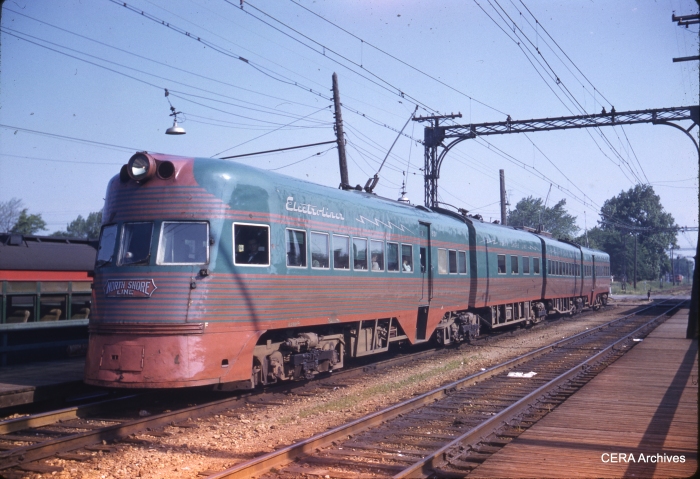
A CNS&M Electroliner in a Kodachrome “superslide” taken on May 26, 1959. (In this case, the photographer used size 828 roll film for an image slightly larger than 35mm.) Such streamlined cars once provided hi-speed rail service between Chicago and Milwaukee that would cost billions to replace today.
As George W. Hilton and John F. Due wrote in their classic 1960 book The Electric Interurban Railways In America (page 4):
The building of the interurbans, which must be looked upon from the vantage point of history as unfortunate, occurred because the electric streetcar was developed to a high degree of technological perfection a little more than a decade before the automobile.
That was certainly the dominant view in 1960, very nearly the end of what the late author William D. Middleton called “The Interurban Era,” in his classic 1961 book of the same name. At the time, it seemed as though both streetcars and interurbans were just a passing phase that (literally) helped pave the way for a world of asphalt and rubber tires.
When Hilton and Due revised their book in 1964, it seemed as though you could put a bookend on the entire interurban era. There was little to report, other than how both Pacific Electric and the North Shore Line had recently abandoned, leaving the South Shore Line as practically the nation’s last remaining interurban line. Even the Red Arrow lines were reported as planning to substitute buses for all routes other than Norristown by the end of the 1960s- and, in fact, the Ardmore line did so at the end of 1966. Fortunately, the Media and Sharon Hill lines are still run by trolleys, and it is hard to imagine them being replaced by buses now.
Streetcars and interurbans were history; they represented the past, one before autos and highways dominated. To many, even building the nation’s extensive interurban network was a mistake; simply a “series of unfortunate events,” leading to financial ruin and eventual abandonment.
Things seemed to have reached a nadir around the early 1970s, as abandonments continued among the handful of remaining systems, and the last American PCC streetcars were already more than 20 years old. Even when Boston and San Francisco made a joint order for modern LRVs from Boeing-Vertol, things seemingly did not get much better. There were so many design and quality control issues that it did not seem possible to build a successful American streetcar in 1975, even though thousands of PCCs were built between 1936 and 1952.
However, all that changed with the opening of the San Diego Trolley in 1981. Suddenly, the trolley was “cool” again, in the new guise of “light rail.” Over time, cities across America started building them, occasionally in the same rights-of-way that had previously been used by streetcars and interurbans. I am glad that Spencer Crump, who predicted that the PE’s “Red Cars” would someday return to LA, lived long enough to actually see it happen, despite all the naysayers. It seemed improbable when he predicted it, but he was proven right in the end.
It would have been better (and cheaper) to keep the best parts of the electric railway network we once had, rather than rebuild parts of it from scratch. As late as 1963, we had high-speed intercity rail running between Chicago and Milwaukee. It was called the North Shore Line. It would cost untold billions to put it back as high-speed rail. Meanwhile, the Japanese were inspired by CNS&M’s Electroliners to create their own Bullet cars. Whereas we were once the leader in intercity rail, we must now play catch-up to Europe and other parts of the world.
Even the word “streetcar” is coming back into vogue, as witnessed by this article in Mass Transit magazine, “Not Your Grandfather’s Streetcar.” And what is today’s “high speed intercity rail” but an updated version of yesterday’s interurban? So, in these matters, we try to take a more balanced view today. We need streetcars and interurbans, by whatever name you call them, every bit as much as we need automobiles and highways.
What’s even more gratifying is how, in a few cases at least, cars that originally ran in a city have actually returned to run again in the same place they started. For example, Aurora, Elgin & Fox River car 304, a lightweight interurban car built by St. Louis Car Co. in 1923, returned to the Fox River Trolley Museum in 2009, and now runs on the last remnant of AE&FR trackage. How it got back after last having run there in 1935 is an interesting and convoluted story.
As Don’s Rail Photos notes, car “304 was built by St Louis Car in 1924. #1306. In 1936 it was sold CI/SHRT (Cleveland Interurban RR became Shaker Heights Rapid Transit in 1944) as 304 and in 1954 it was sold to CP&SW as 304. It was sold to Fox River Trolley Museum in 2009.” We have pictures showing car 304 and its sister car 303 (now at the Northern Ohio Railway Museum) in Cleveland and at “Trolleyville USA,” aka the Columbia Park and Southwestern. (The latter was a trolley museum run by Gerald E. Brookins and his family for about 50 years, and although derided by some for having inauthentic paint schemes on cars, was instrumental in preserving a large number of rail cars that otherwise would have been scrapped.)
We expect to ride AE&FR car 304 on Sunday, September 22, 2013, on a CERA fantrip that will be part of our 75th anniversary celebrations. We hope that you will join us.
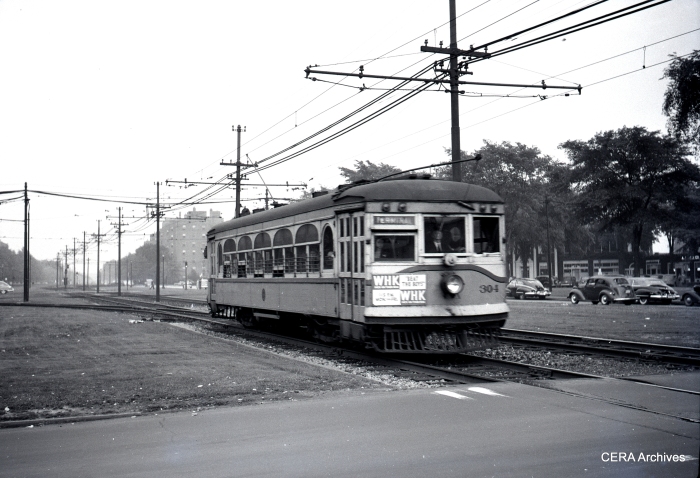
AE&FR car 304, now returned to Fox River, shown here circa 1950 in Cleveland Rapid service.

AE&FR car 303, sister to 304, at the Columbia Park and South Western (aka “Trolleyville USA”) in November 1963, in this photograph by R. S. Short.
Fort Collins (CO) Birney car 21 is another example. The Ft. Collins system, last in the nation to run Birneys, was abandoned in 1951. But there were plans to bring them back, at least in limited form, by the late 1970s. The Fort Collins Municipal Railway Society brought car 21 back to Colorado and it has been running in its old stomping grounds since 1984. A second original Birney is now undergoing restoration so it too can be put back into service.
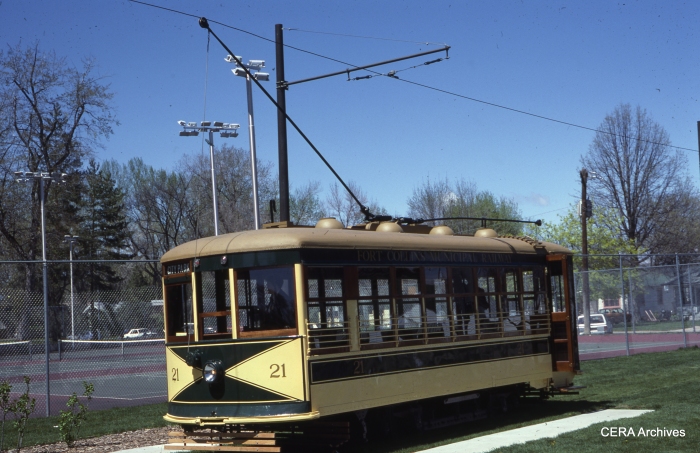
Ft. Collins Municipal Railway Birney car 21, as it looked on April 27, 1986, in this photograph by Ed Fulcomer.
A similar success story is in the making with at least one Dallas double-end PCC car. Again, fromDon’s Rail Photos:
612 was built by Pullman-Standard in 1945, #W6699. It was sold as MTA 3334 in 1959 and sold to Trolleyville in 1991. It was transferred as Lake Shore Electric Ry in 2006. It was sold to McKinney Avenue Transit Authority and stored at Illinois Railway Museum in 2010.
There are many fine photos showing this car, or its sister cars, in both Dallas and Boston. Once 612 is restored, we hope it will once again ride the rails of Dallas streets, back where it belongs.

Dallas Railway and Terminal Co. car 616, sister car to 612, in Dallas Texas in July 1946.
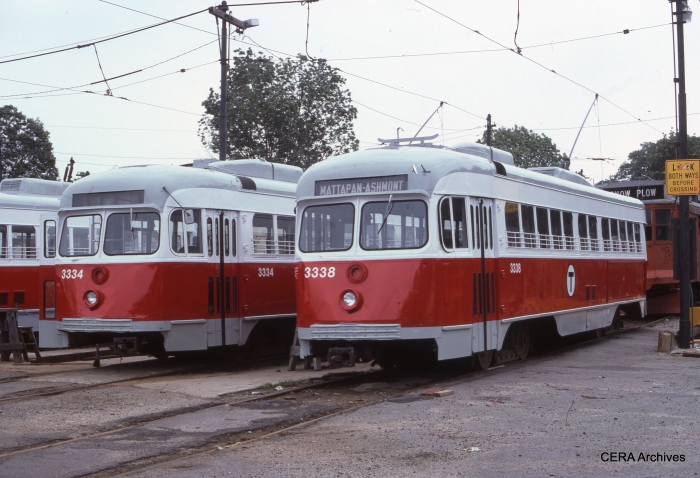
Ex-Dallas double-end PCC car 612 was renumbered as 3334 in Boston, and is shown there at left. This car may be restored to run again in Dallas.
Finally, Nine El Paso pre-war PCC cars, currently languishing in the desert, may someday be restored to run in that city. The El Paso streetcar system was abandoned in 1974, representing in some respects the low point for streetcars in the US prior to their revival. Yes, my friends, streetcars are definitely making a comeback, and they may soon be coming to a street near you. What goes around sometimes comes around.
-David Sadowski
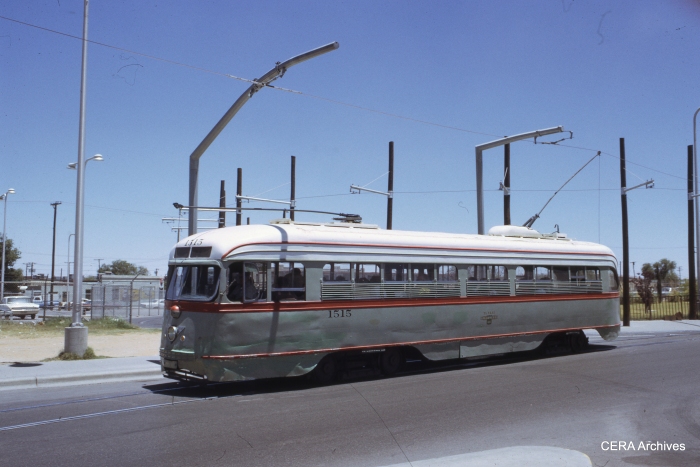
El Paso City Lines pre-war PCC 1515 in June 1971. It’s possible this same car may be restored and once again run on the streets of El Paso.